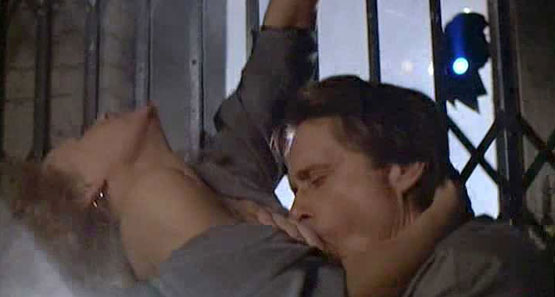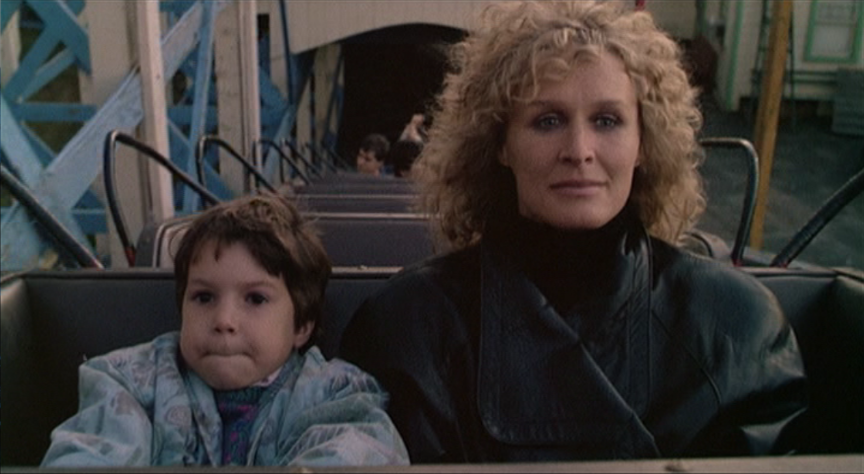Boo! It's a bonus episode of "Oscar Horrors". We're looking back on horror-connected Oscar nominations until Halloween. Here's Daniel Crooke on a Best Picture nominee's brilliant rhythms
Fatal Attraction wants you to keep your doors locked. It gets off on invasion, on lulling you into a false sense of security, sneaking in through the back gate, and shredding the nerves of you and everyone inside. And then it wreaks increasingly deranged havoc with maniacal glee. Such manipulation is not only the mark of a great psychopath but of a great editor, as well. In Fatal Attraction, you’ve got both; Glenn Close’s rhapsodic performance as jilted stalker Alex Forrest slashes at unexpected intervals but she meets her match in the finely screw-tuned cuts of Michael Kahn and Peter E. Berger. Adrian Lyne’s classic cautionary tale of infidelity gone wrong and what happens when you turn down someone’s invitation to the opera goes for the jugular (and the groin and the brain) but it’s up to Kahn and Berger to keep your guard down, raise the hairs on your neck, and provide a clear path for Close to sneak up behind you with the knife.

In Fatal Attraction, you’ve got both: Glenn Close’s rhapsodic performance as jilted stalker Alex Forrest slashes at unexpected intervals but she meets her match in the finely screw-tuned cuts of editors Michael Kahn and Peter E. Berger. Adrian Lyne’s classic cautionary tale of infidelity gone wrong and what happens when you turn down someone’s invitation to the opera goes for the jugular (and the groin and the brain). But in the end it’s up to Kahn and Berger to keep your guard down, raise the hairs on your neck, and provide a clear path for Close to sneak up behind you with the knife.
Nine years of happy marriage, an adorable and adoring young daughter, and an immaculate Manhattan apartment (with a big family dog to boot) has left hotshot attorney Dan (Michael Douglas) with all the conventional hallmarks of societal success and a nagging pair of blue balls. The family cozily cohabitates, lounging around like a den of happy lions, but the slack pace and disjunctive economy of shots coats the flat in a suggestion that ignorance is domestic bliss. In the opening scene, the crisscross cuts between Dan and his wife Beth (Anne Archer) calling back and forth to one another in separate rooms while getting ready for the same party signals a latent lack of togetherness built around habitual, cozy beats. Kahn and Berger coax your guard down by leaving plenty of breathing room in scenes at home between spouses – and they will continue to trick you into a resting heart rate with scenes of banal sanctuary. This is a false security leaving plenty of entry points to exploit.
In an especially sexually frustrated Kuleshov experiment, they hold on Dan’s face while his horndog hopes of getting laid melt away into disappointed acceptance and then they cut to show us that his daughter Ellen has decided to spend the night in her parents’ bed. By pacifying tension between Dan and Beth with an easygoing pace but expressly demonstrating the cracks in their home life, Kahn and Berger leave plenty of open doors for an intruder that will catch the sleeping audience off guard.
The limp rhythms of Dan’s home life feel especially flaccid once Alex Forrest enters the picture. The electricity that Close sparks with each charged glare accomplishes much of the work but there are clear visual signals that Dan feels more alive and connected in these moments than he does back home. In their first couple of encounters, we see Dan and Alex flirtatiously parry together in two-shots or group shots. Their immediate chemistry and camaraderie feels more intimate than the schematics (and accompanying cuts) of his American family. Kahn and Berger choose not to cut until their second encounter, when a striking close-up of Alex interrupts a business meeting. She secretly signals to Dan that he has cream cheese on his face, above his lip, and then we cut to his accompanying close-up, turned on. It’s a moment of pure potential sex, infiltrated by the editors’ choice to disrupt the visual sameness they’ve used to hypnotize the audience. Their first sex scene is a horny mash-up of overeager, thirsty cuts of carnality; the shots become quicker, the film develops a sense of humor by using insert shots of bubbling kettles and spinning fans as euphemism, blood begins to pump in the film’s veins. Normalcy disappears. It is replaced by the pulses of a raging id.

After their weekend tryst, Dan rejects Alex. Once she begins her vengeance over the family, the film becomes marked by brief moments of accelerated terror brought to life by jarring shifts in motion and shot set-up. In the film’s most infamous scene, Kahn and Berger jump between Beth’s soft, slow approach to a mysterious boiling pot and a dizzy, fast tracking shot of Ellen’s feet sprinting in the backyard to her pet bunny’s cage. While Beth’s pace remains stagnant, the disorientation of the rushing motion and uncomfortable framing of Ellen’s chase intensifies with the addition of swift shots of the bubbling pot at askew angles. By the time she lifts the handle, the cuts speed up to a breakneck clip between horrified mother, clueless father, and shrieking daughter; the family unit completely disrupted by a tense mania that can only mean Alex is afoot. We barely see the dead rabbit cooking in the pot but we don’t have to – the true horror in the scene comes from the unsettling realization that security is an illusion, generated by the editors’ time-warping invasion.
Later, when Alex kidnaps Ellen and takes her to a rickety amusement park, they juxtapose the churning chaos of their roller coaster ride with a distraught Beth (mostly captured in close-up and point of view shots) driving through traffic to find her daughter. By the time they cut between the coaster flying down the track to Beth crashing into the car in front of her, they have taken security completely off the rails.

Editing is as much about the long-form rhythms that pattern a film as it is the showier forms of montage that whip, whirl, and dazzle you with frenetic flurries of image. One necessitates the impact of the other. Fatal Attraction finds mood through the pacing and shot variety of its peaceful scenes of domesticity versus the ones that coil danger in plain sight. Once Alex has weaseled her way into Dan’s life – namely, by exploiting his impotency – the visual modes of the film swerve with unhinged outbursts of violence and danger. The potency of Fatal Attraction’s most wacko moments relies on how the established parallelism that Kahn and Berger have built between Dan’s humdrum home life and stimulating, taut combat with Alex eventually intersect – when the danger of the latter overtakes the placidity of the former.
In this sense, the editing of Fatal Attraction is a nightmare generator. First, it establishes a supposedly static safe zone based on the rules and rhythms of your everyday life. Then, it exploits a central psychological vulnerability in order to find an open window to creep inside and subtly shifts the dimensions. Finally, through complete distortion of the dull atmosphere that made you feel secure in the first place, you are trapped with the monster you’ve allowed inside the house.

Season 3 Oscar Horrors is a Wrap
The Bad Seed - Supporting Actress
Bram Stoker's Dracula - Makeup
Dr Jekyll & Mr Mouse -Animated Short
Flatliners - Sound Editing
Kwaidan - Foreign Film
Misery - Actress
Pan's Labyrinth - Production Design
The Sixth Sense - Picture
Sleepy Hollow - Production Design
Sweeney Todd - Best Actor
The Uninvited - Cinematography
Whatever Happened to Baby Jane? - Cinematography